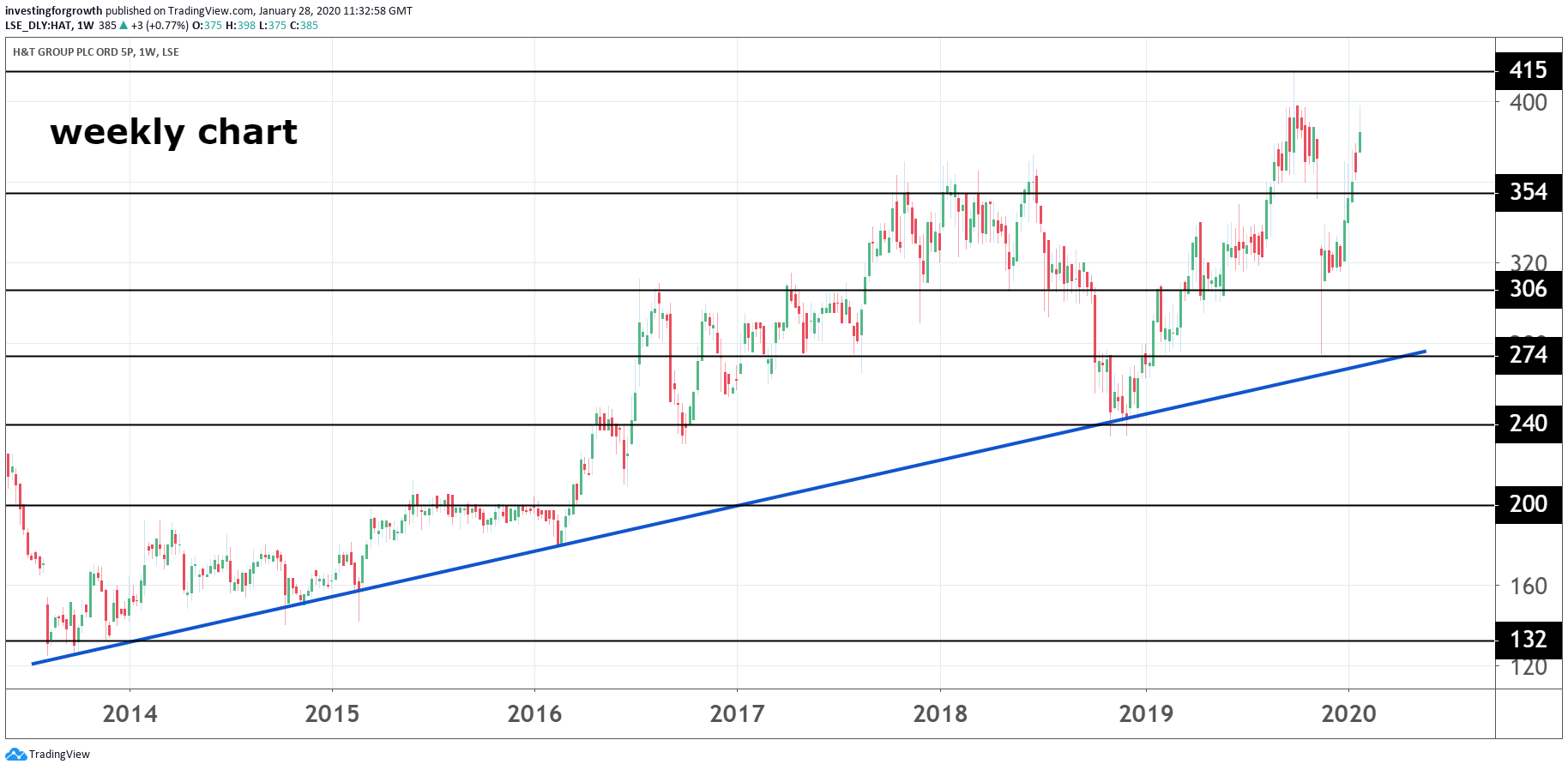Stockwatch: An AIM share with upgrade potential
It’s having a great 2020, and our companies analyst believes economic conditions favour further success.
28th January 2020 11:19
by Edmond Jackson from interactive investor
It’s having a great 2020, and our companies analyst believes economic conditions favour further success.

How’s the risk/reward profile shaping up for this £152 million “financial” group, amid strong gold prices, but an ongoing regulatory probe into this pawnbroker/retailer/lender’s “payday loan” side?
At around 380p, the AIM-listed shares of H&T Group (LSE:HAT) have almost fully recovered from a plunge to 315p, largely in response to last November’s news of a Financial Conduct Authority (FCA) probe into high-cost short-term unsecured lending. It anyway only represented 4% of revenues, the company said in its 18 November statement.
- 8 best mid-cap stock ideas
- Take control of your retirement planning with our award-winning, low-cost Self-Invested Personal Pension (SIPP)
The market price bumped along sideways, ignoring even the general election result that tended to fuel domestic financial stocks, perhaps amid doubts over jewellery demand. Yet a re-rating began in the New Year, helped by the similar (barring foreign exchange) AIM-listed Ramsdens Holdings (LSE:RFX) updating bullishly on 8 January.
H&T shares have now risen around 6% on news that its 2019 profits will be at the top end of expectations and, with gold prices strong amid global uncertainties, it’s timely to consider the possibility that this type of stock will outperform.

Source: TradingView Past performance is not a guide to future performance
Modestly rated as underlying momentum builds
Yesterday’s trading update implies a modest beat on the expectation of a 30% rise in consensus net profit to £14.3 million, with normalised earnings per share (EPS) growth of around 26%. Around 22% EPS growth to over 45p was targeted for 2020, implying a forward price/earnings (PE) of just 8.2x, and it is possible that both forecasts and H&T’s rating edge up. On the basis of dividend growth re-rating from mid-single-digit to mid-teen percentage growth this year, the prospective yield is 3.6%.
Ramsdens (at 240p) trades on a12-month forward PE of 11.5x (March year-end) and a 3.3% yield, albeit forecasts are only for a flat 2020/21 year in terms of profit/earnings, so might be due some upgrades. Investor wariness about news and used jewellery sales being the ultimate in discretionary spending, is easing as both companies have shown adept marketing – Ramsdens especially so, in premium watches. Slower-moving used stock now has greater potential for scrapping to capitalise on high gold prices.
See also from the table how free cashflow numbers have re-rated in the last two years, so it will be interesting to see the upshot when H&T declares full-year results on 10 March.
| H&T Group - financial summary | ||||||
|---|---|---|---|---|---|---|
| Year ended 31 Dec | 2013 | 2014 | 2015 | 2016 | 2017 | 2018 |
| Turnover (£ million) | 99.3 | 87.7 | 89.2 | 94.2 | 125 | 143 |
| Operating margin (%) | 7.6 | 7.1 | 8.4 | 10.6 | 10.0 | 11.4 |
| Operating profit (£m) | 7.6 | 6.2 | 7.5 | 10.2 | 12.5 | 16.2 |
| Net profit (£m) | 4.9 | 4.3 | 5.4 | 7.6 | 9.5 | 11.0 |
| Reported earnings/share (p) | 13.4 | 11.8 | 14.9 | 20.9 | 25.9 | 29.6 |
| Normalised earnings/share (p) | 19.4 | 17.5 | 14.9 | 21.4 | 29.6 | 31.9 |
| Price/earnings multiple (x) | 11.9 | |||||
| Operating cashflow/share (p) | 42.5 | 39.8 | 31.0 | 3.6 | -9.5 | 19.4 |
| Capex/share (p) | 6.7 | 3.1 | 3.3 | 5.3 | 4.8 | 9.1 |
| Free cashflow/share (p) | 35.8 | 36.7 | 27.7 | -1.7 | -14.3 | 10.3 |
| Dividend per share (p) | 4.8 | 4.8 | 7.6 | 9.2 | 10.5 | 11.0 |
| Dividend yield (%) | 2.9 | |||||
| Covered by earnings (x) | 2.8 | 2.5 | 2.0 | 2.3 | 2.5 | 2.7 |
| Net debt (£m) | 20.4 | 9.4 | 2.0 | 5.1 | 13.1 | 36.1 |
| Net asset value/share (p) | 239 | 247 | 255 | 267 | 266 | 276 |
| Source: historic Company REFS and published accounts | ||||||
Interims had shown a 5.4% rise in operating cash flow before working capital changes, to £11.5 million, and a 147% jump to £9.3 million after them. This implies scope both for dividend growth and also to consider H&T as modestly-rated in cashflow terms – currently around 14x free cashflow for 2018 and has risen recently. Applying the philosophy of Ockham’s razor - the more assumptions you have to make, the more unlikely an explanation - the key reason looks like higher gold prices versus a relatively stable cost base.
39% annual growth in pawnbroking pledge book
H&T cites growth in its pawnbroking pledge book up to £20 million at end 2019, helped by increased lending to newly-acquired customers and organic growth in transactions. While UK political stasis may have tested personal finances as well as with business investment, it bodes well for 2020.
Revisiting the 2018 accounts for context, 50% of gross profit was derived from pawnbroking (despite a £10.4 million impairment charge) relative to 11.1% from personal loans (suffering £15.5 million impairment), 21.2% from retail, 6% from gold purchasing and 2.2% from pawnbroking scrap – the remainder “other services”.
So, pawnbroking is a key driver, and impairment charges are an important aspect to bear in mind – as if the stock rating will always be tempered, never fully reflecting earning power due to uncertainty.
With that caveat clear, a single-figure PE in chastened times for households, and high gold prices, is low. Given H&T has a relatively modest 40 million shares in issue, better profits and cashflow will drop down usefully to ‘per share’ values.
Joins the dots with improvements manifesting a year ago
At end-2018 I was intrigued how smaller financial stocks had taken a particularly hard battering in the fourth quarter market sell-off. It’s why I backed H&T as a “buy” at 260p and reiterated this at 290p the following March.
Virtually all its operations were showing progress and a well-managed pawnbroker seemed an appropriate core business for a difficult consumer environment. H&T’s strategic goal had broadened towards “the premier provider of alternative credit in the UK that help our customers protect and rebuild their credit rating and return to the mainstream.”
It appeared management was striking a balance to serve people excluded by mainstream finance without getting caught by regulators, justifiably intent on protecting those vulnerable from high interest rates.
However, I underestimated the risks with a “payday loans” type of business where high-cost short-term unsecured lending (HCSTC) is clearly under scrutiny – hence, the FCA's intervention.
There has been a series of failures such as Wonga, The Money Shop and QuickQuid – typically under a weight of compensation claims as legal liabilities on lenders have grown. At issue here are H&T’s assessment of creditworthiness and its lending processes in light of changes to rules affecting affordability, as implemented in November 2018.
- Five AIM share tips for 2020
- Six speculative UK share ideas for 2020
- Like AIM and small-company shares? Check out ii’s Super 60 recommended funds
Interims showed that, while the average monthly net loan book had increased by over 20% to £20 million, the proportion of HCSTC loans had fallen from 50% to 36% year-on-year.
The latest update cites this FCA review as ongoing, during which time all HCSTC unsecured lending has been ceased, at least temporarily. A positive upshot therefore is an ability to have guided 2019 profit to the top end of expectations.
So, the problem has chiefly been perception; H&T having said last August it was able to meet all new requirements with minimal changes, then November’s jolt. The risk is an as yet unquantified redress to customers and/or fine, although last November H&T anticipated being able to fund this from existing resources.
At end-June it had £9.5 million cash with the annual dividend costing around £4 million. However, cash generation is strong and the outlook continues to improve, so I very much doubt any further bad news regarding the FCA will genuinely impact finances.
Risk/reward continues to tip favourably for the medium term
More likely it was the aspect of surprise, about how H&T’s market value dropped around £40 million from 377p to 315p last November, although, in terms of profitability, the effect for 2019 was cited at 4% and the outlook is at the top end of expectations anyway. Revenue less impairment from short-term lending has averaged under £2 million a year in the last three years, so it would probably take a recession to impact worse.
In the near-term, there is some risk of a financial slap in order to draw a line under “payday loan” concerns. With fresh money, one might try to be cute, waiting for this to happen, although by the time it arrives the stock could have traded higher.
Gold prices also remain inherently uncertain. Conservative investors should beware over-optimistic “gold bugs” that crawl out with every bull market. Yet the cocktail of global uncertainties driving it higher – from coronavirus to Iran and Donald Trump’s possible impeachment in a presidential election year – continues to stir. What can pull gold back?
I certainly wouldn’t dispute holders of Ramsdens share, although its foreign exchange services could be affected if viral fears impact global travel this year, and H&T looks to have rating catch-up potential.
So, I retain my stance: Buy.
Edmond Jackson is a freelance contributor and not a direct employee of interactive investor.
These articles are provided for information purposes only. Occasionally, an opinion about whether to buy or sell a specific investment may be provided by third parties. The content is not intended to be a personal recommendation to buy or sell any financial instrument or product, or to adopt any investment strategy as it is not provided based on an assessment of your investing knowledge and experience, your financial situation or your investment objectives. The value of your investments, and the income derived from them, may go down as well as up. You may not get back all the money that you invest. The investments referred to in this article may not be suitable for all investors, and if in doubt, an investor should seek advice from a qualified investment adviser.
Full performance can be found on the company or index summary page on the interactive investor website. Simply click on the company's or index name highlighted in the article.
Disclosure
We use a combination of fundamental and technical analysis in forming our view as to the valuation and prospects of an investment. Where relevant we have set out those particular matters we think are important in the above article, but further detail can be found here.
Please note that our article on this investment should not be considered to be a regular publication.
Details of all recommendations issued by ii during the previous 12-month period can be found here.
ii adheres to a strict code of conduct. Contributors may hold shares or have other interests in companies included in these portfolios, which could create a conflict of interests. Contributors intending to write about any financial instruments in which they have an interest are required to disclose such interest to ii and in the article itself. ii will at all times consider whether such interest impairs the objectivity of the recommendation.
In addition, individuals involved in the production of investment articles are subject to a personal account dealing restriction, which prevents them from placing a transaction in the specified instrument(s) for a period before and for five working days after such publication. This is to avoid personal interests conflicting with the interests of the recipients of those investment articles.